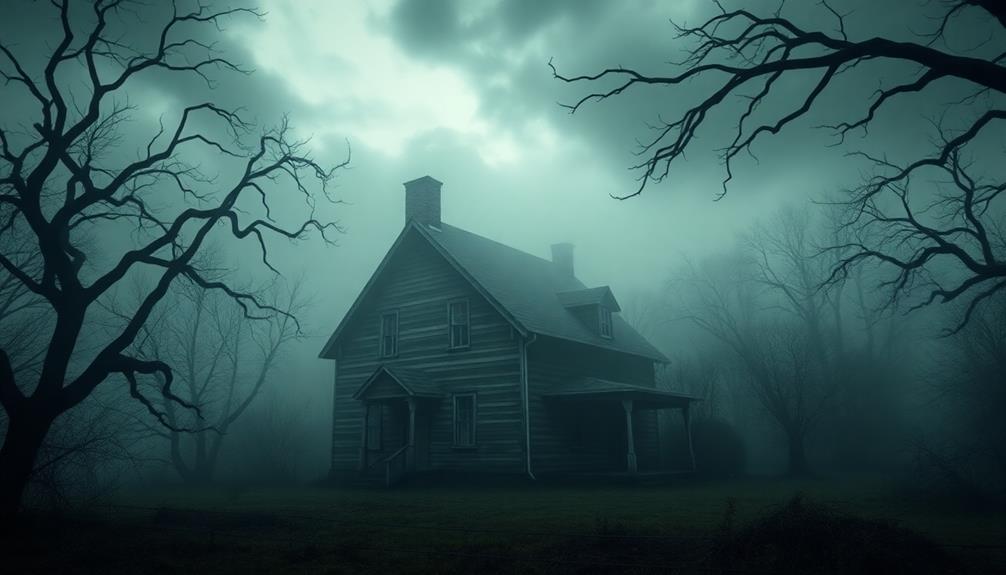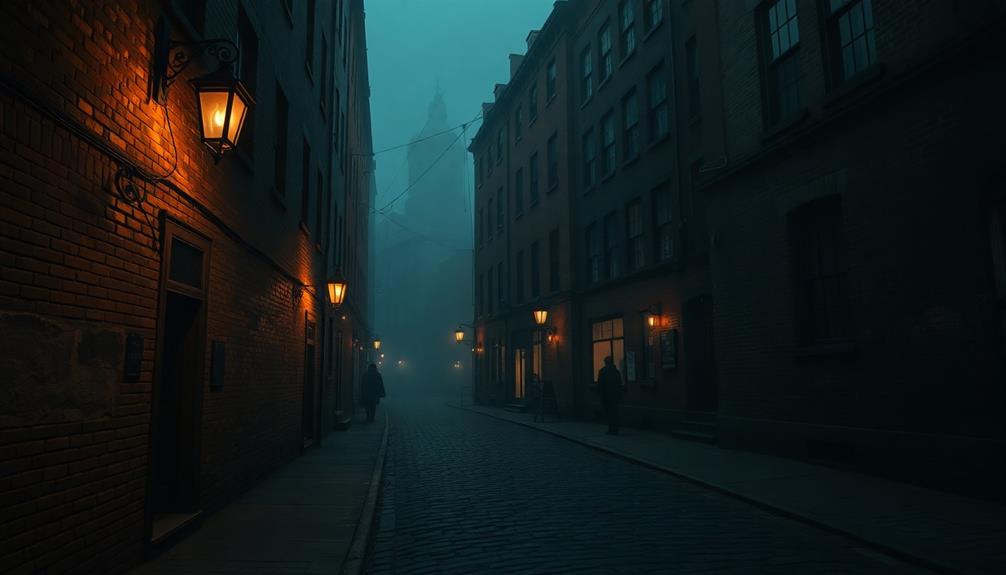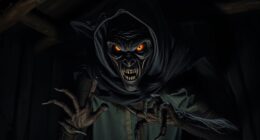The real story behind The Conjuring House is much scarier than the movie depicts. The Perron family, who lived there from 1971 to 1980, endured terrifying hauntings, including spectral sightings and physical assaults. Ed and Lorraine Warren investigated the case, uncovering a history tied to Bathsheba Sherman, a grieving mother wrongly labeled a witch. While the film stimulates fear with a singular evil, the family's true experiences involved layers of different spirits. Misconceptions abound, distorting real events into a sensational tale. If you want to uncover the haunting details that separate fact from fiction, there's much more to discover.
Key Takeaways
- The Perron family endured nearly a decade of hauntings in the Arnold Estate farmhouse, experiencing moving objects and ghostly apparitions.
- Bathsheba Sherman, often depicted as a malevolent witch, was actually a grieving mother with a tragic life, distorting her true story.
- Ed and Lorraine Warren conducted their investigation with caution, focusing on understanding spirits rather than performing sensationalized exorcisms.
- The film exaggerates the Warrens' involvement and portrays Bathsheba as a primary antagonist, misrepresenting the family's real experiences with various spirits.
- Historical context reveals the farmhouse's rich background and lingering spirits, contrasting with the film's dramatized narrative.
The Perron Family's Haunting
The Perron family experienced a decade of chilling hauntings in the Arnold Estate farmhouse, where they lived from 1971 to 1980. As they settled in, the family quickly realized they weren't alone. Objects moved inexplicably, and ghostly apparitions became a common sight.
Carolyn Perron took it upon herself to research the property's dark history, uncovering the tragic tale of Bathsheba Sherman, believed to be the primary tormentor.
The paranormal activity escalated over time, with Carolyn sometimes speaking in an unknown language during séances held with Ed and Lorraine Warren. The daughters, especially Andrea, described a range of spirits—some friendly, others malevolent.
The haunting evolved from benign encounters to terrifying events, including physical assaults that left the family on edge.
Despite the escalating terror, financial struggles kept the Perrons rooted in the farmhouse, forcing them to endure the torment for nearly a decade. Each day brought new challenges, as the haunting persisted, complicating their lives in unimaginable ways.
The ordeal shaped their experiences, and the haunting of the Perron family remains a chilling chapter in the history of the Arnold Estate.
Ed and Lorraine Warren's Investigation

When you look at Ed and Lorraine Warren's investigation, you'll see a mix of chilling paranormal events and intense personal experiences.
The infamous séance, where Carolyn Perron reportedly levitated and spoke in an unknown language, showcases the urgency of their mission.
As they employed various investigation methods, the Warrens aimed to uncover the truth behind the haunting at the Arnold Estate.
Paranormal Events Overview
Often regarded as one of the most chilling cases in paranormal history, Ed and Lorraine Warren's investigation of the Perron family's haunting at the Arnold Estate began on Halloween night in 1973. They identified Bathsheba Sherman as the malevolent spirit behind the terrifying supernatural events that plagued the family.
During their investigation, you'd find the following alarming occurrences:
- Apparitions: The Perron family witnessed ghostly figures roaming their home.
- Physical Attacks: Family members reported being pushed and scratched by unseen forces.
- Possession: Carolyn Perron experienced a severe possession during a séance, manifesting in levitation and speaking in an unknown language.
The Warrens documented these paranormal events, visiting the farmhouse multiple times in 1974 to provide assistance.
While they sought to understand the haunting, they ultimately decided against performing an exorcism, believing it was unnecessary.
Lorraine later cautioned against self-proclaimed experts in the paranormal field, highlighting the importance of caution when dealing with such potent forces.
The investigation of the Perron family's haunting remains one of the most profound cases in the Warrens' storied career, filled with chilling encounters and supernatural revelations.
Séance and Possession Incident
Amidst the haunting events at the Perron farmhouse, the séance conducted by Ed and Lorraine Warren stands out as one of the most dramatic moments of their investigation.
During this intense session in 1973, Carolyn Perron became the focal point of a chilling possession by a malevolent spirit. Witnesses, including her daughter Andrea Perron, reported seeing Carolyn levitate off the ground and speak in an unknown language, leaving everyone in shock.
Lorraine Warren identified Bathsheba Sherman, a historical figure linked to the property, as the primary source of the paranormal disturbances plaguing the Perron family.
As the séance progressed, Carolyn's behavior took a disturbing turn, growing increasingly erratic and alarming. This prompted deep concern from both the Warrens and the family, as they grappled with the terrifying implications of what was happening.
Despite the dramatic nature of the séance and its aftermath, Lorraine later clarified that an exorcism was never performed on Carolyn Perron during their investigations, leaving many to wonder about the true extent of the possession and its lasting effects on the family.
Warren's Investigation Methods
Ed and Lorraine Warren employed a mix of intuition and rigorous investigation methods during their time at the Perron farmhouse. Their approach combined personal experience with thorough research, allowing them to explore deep into the paranormal activity plaguing the family.
Here are three key aspects of their investigation methods:
- Historical Research: The Warrens researched the farmhouse's history, focusing on Bathsheba Sherman, believed to be the malevolent spirit behind the disturbances.
- Documenting Evidence: They meticulously documented their findings, capturing the family's experiences and the supernatural occurrences that transpired, which helped validate the family's claims.
- Séance Conducting: The Warrens conducted a séance that led to alarming events, including Carolyn Perron's alleged possession. This moment heightened their resolve to address the family's plight.
Despite their extensive investigation, Lorraine later clarified that an exorcism was never performed, challenging the common narrative surrounding their work.
The Warrens were dedicated to helping the Perron family, focusing on understanding the spirit's influence rather than resorting to sensationalized solutions. Their balanced approach left a lasting impact on paranormal investigations.
The Role of Bathsheba Sherman

Bathsheba Sherman played an essential role in the haunting narrative of the Perron family, often depicted as a malevolent witch in popular culture.
However, when you look closer at her historical background, you'll find a more complex picture that challenges the myths surrounding her.
Understanding her true story can help clarify the misconceptions that have fueled the ongoing fascination with the Conjuring House.
Historical Background of Bathsheba
The enigmatic figure of Bathsheba Sherman has become synonymous with the haunting lore surrounding the Conjuring House. Born in 1812 in Rhode Island, Bathsheba's life was marked by sorrow and personal tragedies that shaped her legacy.
Here are three key aspects of her historical background:
- Loss and Grief: Bathsheba suffered the loss of three children, which greatly impacted her reputation and contributed to local folklore.
- Allegations of Witchcraft: Despite claims of her being a malevolent spirit engaged in child sacrifice, historical accounts reveal little evidence to support these allegations.
- Misrepresentation in Media: The portrayal of Bathsheba as a villain in films like The Conjuring contrasts sharply with the more mundane aspects of her life documented in historical records.
Bathsheba died from a stroke in 1885, leaving behind a complex legacy.
While the haunting at the Conjuring House is often linked to her spirit, it's crucial to remember that sensationalism has overshadowed her true story. Rather than a malevolent witch, she was an ordinary woman who faced significant hardships, and her life deserves a more nuanced understanding.
Alleged Malevolence and Impact
Allegations of Bathsheba Sherman's malevolence have greatly shaped the narrative surrounding the Perron family's haunting. You might be surprised to learn that Bathsheba, who suffered the loss of three children and died from a stroke in 1885, was portrayed in the film as a malicious witch, distorting the true story of her life.
The Perron family reported terrifying experiences, including possessions and physical assaults attributed to Bathsheba's spirit. Carolyn Perron claimed she experienced a violent encounter during a séance led by Ed and Lorraine Warren, heightening the fear that surrounded their home.
Andrea Perron, the eldest daughter, described Bathsheba as an entity that instilled chaos and fear, leading to an emotional toll on the family. However, skepticism regarding Bathsheba's characterization persists. Some historians argue that the claims of her malevolence are influenced more by folklore and sensationalism than by factual evidence.
This discrepancy between the true story of Bathsheba Sherman and her exaggerated portrayal fuels ongoing debate, leaving you to wonder how much of the haunting was truly her doing and how much was a creation of dramatic storytelling.
Debunking Myths and Misconceptions
Debunking myths surrounding Bathsheba Sherman reveals a more nuanced reality than what's depicted in "The Conjuring." Contrary to the film's portrayal of her as a malicious witch, historical records show she was a grieving mother who lost three children and died from a stroke in 1885.
The true story of Bathsheba is often overshadowed by misconceptions that have taken root in popular culture.
Here are three key misconceptions you should know:
- Child Sacrifice: The film suggests Bathsheba engaged in horrific acts like child sacrifice, but there's no historical basis for this claim.
- Witchcraft: Instead of being a malevolent witch, Bathsheba was a typical woman of her time, facing the heartache of losing her children.
- Perron Family Haunting: The connection between Bathsheba and the Perron family's haunting is largely based on folklore rather than concrete historical facts.
These myths not only distort Bathsheba's character but also perpetuate stigma surrounding her name.
Differences Between Film and Reality

While watching *The Conjuring*, you might find yourself captivated by the spine-chilling portrayal of Bathsheba Sherman as a malevolent force, but the truth is far more nuanced. The true story behind the Perron family's experiences in the house reveals a complex reality, where not all spirits were hostile.
| Film Representation | Reality | Emotional Impact |
|---|---|---|
| Bathsheba as a primary antagonist | Bathsheba as a grieving mother | Sympathy for her loss |
| Possession leading to chaos | Mixed experiences with comforting spirits | Confusion and fear |
| Ed and Lorraine conducting exorcism | Limited involvement, no exorcism performed | Disappointment in resolution |
The film condenses nearly a decade of events into a gripping narrative, sacrificing accuracy for drama. Ed and Lorraine Warren are depicted as all-knowing, yet their methods weren't as effective or thorough as shown. The differences between film and reality highlight how the haunting was not merely a battle against evil but a struggle with various spirits in the house, ultimately making the true story even more terrifying than the cinematic version.
Historical Context of the Farmhouse

The history of the farmhouse, known as the Farm on Round Top Road, dates back to 1736, making it a significant landmark in Rhode Island. This property has witnessed centuries of events, and its past is rich with intriguing figures and unsettling tales.
Here are three key points to reflect upon:
- Abigail Arnold: Historical records show she lived and died on the property in 1865, adding a layer of mystery to the farmhouse's reputation.
- Bathsheba Sherman: Often sensationalized, she was a neighbor rather than a resident, yet her story has become intertwined with the haunting narrative.
- Perron Family: The farmhouse was home to the Perron family from 1971 to 1980, during which they reported numerous supernatural occurrences that captured the public's imagination.
This blend of history and haunting makes you wonder what spirits might still linger in the shadows.
The farmhouse's age and the events surrounding Abigail Arnold and Bathsheba Sherman raise questions about the past, leaving you intrigued by the potential for unseen forces at play.
Cultural Fascination With the Paranormal

Stories like that of the Perron family tap into a deep-seated cultural fascination with the paranormal, where fear and curiosity intertwine. You might find it compelling how their real-life haunting has become a focal point for discussions about the supernatural.
As platforms like Freesat highlight paranormal content, this growing interest reflects society's desire to explore unexplained phenomena.
The success of The Conjuring franchise has only amplified this fascination, merging historical events with cinematic storytelling. People are drawn to ghost stories not just for entertainment, but also for the authenticity that comes with true accounts of hauntings. The emotional scars left on the Perron family resonate with audiences, making the experience feel relatable and real.
At the same time, there's a division among the public regarding the authenticity of the Warrens' investigations. This skepticism, coupled with curiosity about life after death, fuels ongoing conversations about the paranormal domain.
You might notice how communication with spirits and the reasons some souls remain earthbound prompt deeper inquiries into existence itself. Ultimately, this cultural fascination with the paranormal reveals our unending quest for understanding in a world filled with mysteries.
Legacy of The Conjuring House

Legacy of the Conjuring House reverberates through popular culture, enchanting audiences with its blend of history and horror. The tales of the Perron family's haunting experiences and the notorious spirit of Bathsheba Sherman have left an indelible mark on the paranormal landscape.
Here are three key elements of this legacy:
- Real Experiences: The true account of the Perron family's life in the house from 1971 to 1980, filled with possessions and unexplained occurrences, continues to captivate true believers and skeptics alike.
- Cultural Impact: Following the 2013 film, the Conjuring House became a focal point for paranormal investigators, inspiring documentaries and further media narratives that explore the intricate web of supernatural folklore.
- Enduring Mystique: The ongoing discussions about the legitimacy of the hauntings and the historical context contribute to its reputation as a significant site for exploration, drawing enthusiasts keen to uncover the truth behind the haunting.
As you explore this legacy, you can't help but feel the chill of history mixed with the thrill of the unknown, ensuring the Conjuring House remains a hauntingly relevant part of our cultural narrative.
Frequently Asked Questions
What Is the Real Story Behind the Conjuring House?
The real story behind the Conjuring House involves the Perron family's terrifying experiences with supernatural occurrences, including possessions and haunting spirits, which were investigated by Ed and Lorraine Warren, raising both fascination and skepticism among audiences.
How Much of the Conjuring Was True?
You step into a shadowy farmhouse, whispers of the past echoing around you. Much of "The Conjuring" is rooted in the Perron family's eerie experiences, though some details are amplified for cinematic suspense.
Is the Conjuring House Still Haunted Today?
Yes, the Conjuring House is still haunted today. You'll experience eerie sensations, such as books falling and unexplained noises. Many guests report encounters with shadowy figures, making it an enthralling destination for paranormal enthusiasts.
Is Bathsheba Sherman Based on a Real Person?
Absolutely, Bathsheba Sherman's a real person. While the film frames her as a fearsome figure, her life was filled with sorrow and loss, lacking any solid evidence of the sinister deeds attributed to her.
Conclusion
As you step away from the chilling tale of the Conjuring House, imagine the shadows of the past lurking like whispers in the dark. Just like the secrets buried beneath the floorboards, the true story is often more haunting than fiction. The Perron family's ordeal reminds you that history can be a ghostly echo, vibrating through time, urging us to confront our fears rather than shy away from them. The line between reality and myth is thinner than you think.










